By Gussie Fauntleroy
Ray Hare
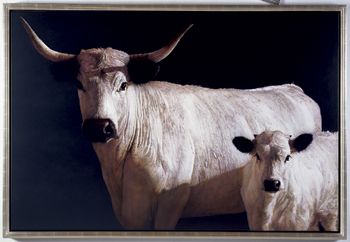 |
| LIKE MOTHER, ACRYLIC, 48 X 72. |
It’s not the big bang Ray Hare is after—or rather, it’s not only the big bang. The California-based artist is pleased when his work makes an impact, and indeed, he’s seen more than one viewer unconsciously take a step back-ward after coming upon, for example, his 7-foot-tall portrait of a lion’s head or his 6-foot-wide LIKE MOTHER. But up close, and viewed over an extended period, Hare’s impressive paint-ings—averaging 5 by 7 feet—offer layers of interest and contemplation.
For one thing, he draws on the laws of physics when painting the edges of things in magnified detail. Where an object’s edge actually rolls around and continues in space beyond what we can see, the artist enhances that sense of depth through light refraction and the inclusion of a subtle after-image. “So now the ‘hard’ edge can suddenly move a little,” he explains. “It simulates life and energy. It simulates what you see with the eye.”
What the viewer is more likely to be aware of, perhaps, is a painting’s exquisite photo-realistic character when seen from a distance, and its abstract qualities up close. That, and the natural beauty of the subject. And therein lies the artist’s own inspiration. “What an incredible thing, that there are these creatures that walk or fly across the earth or swim the vast seas,” he marvels. “It’s quite a miracle.” Hare is represented by Coda Gallery, Park City, UT, New York, NY, and Palm Desert, CA; Legacy Gallery, Jackson Hole, WY, and Scottsdale, AZ; and William & Joseph Gallery, New Orleans, LA.
Kate Breakey
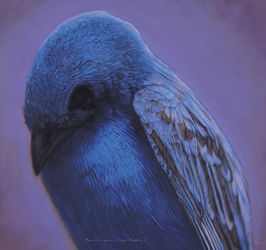 |
| INDIGO BUNTING 2, HAND-COLORED PHOTOGRAPH, 32 X 32. |
Some artists are fascinated by small-scale life; Kate Breakey’s eye and heart are caught by small deaths. Sometimes these are wilting flowers, stilled lizards, or butterflies, but most often they are birds. The Australian-born artist photographs them in the state they come to her, perhaps with head bowed from broken neck, or in varying states of feather loss or skeletal exposure.
She prints the photos almost three feet square on matte paper. Then she hand-colors each with layers of oil paint and colored pencil, translucent enough to retain a sense of photography but richly enhanced with naturalistic color. The process combines the artist’s two passions, photography and painting, both of which she studied at the University of South Australia before moving to the United States. It also serves as her way of understanding and expressing, with tenderness and respect, the uncounted, undocumented deaths all around us every day.
While called Small Deaths, Breakey’s large-scale images have an impact that is anything but small. “I make them larger than life. I make them my size, so we’re on equal ground, so I can meet them eye to eye,” she explains. “I do this as a gesture of wonder, desire, and love.” Breakey’s images may be seen at Stephen L. Clarke Photography, Austin, TX; Gerald Peters Fine Art, Dallas, TX; McMurtrey Gallery, Houston, TX; Etherton Gallery, Tucson, AZ; and Segura Art, Phoenix, AZ. The first of two books of her art, Small Deaths (University of Texas Press, 2001), contains 81 color images from the ongoing series.
Adele Earnshaw
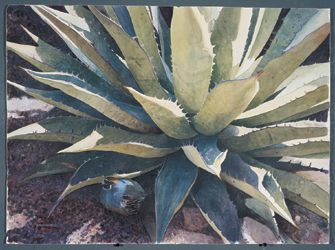 |
| MAY COLORS, WATERCOLOR, 25 X 32. |
Adele Earnshaw’s native New Zealand is a land of birds. Virtually every mammal on the island nation was brought from elsewhere in recent centuries, allowing an amazing variety of bird life to develop without predators. Growing up next to an estuary surrounded by lush subtropical forests, Earnshaw knew no wild mammals bigger than a hedgehog. But she knew birds, and her strong connection with flighted creatures remained after her family moved to the United States when she was 11.
Living in a canyon near Sedona, AZ, for the past 28 years, the widely collected artist models her approach to wildlife painting after the often inconspicuous nature of birds—like the tiny owl perched one day on a branch right in front of her. She saw no bird until the owl’s head turned all the way around to look at her.
Earnshaw’s primary artistic passion is composition, yet within each delicately detailed watercolor is at least one bird, always in the context of an environment where it naturally would be found. “It doesn’t matter what the subject is,” she explains. “If I see an interesting composition and if I can put a bird in it, I’ll paint it.” Earnshaw’s paintings have been exhibited at such venues as the Natural History Museum in New York and the National Museum of History in Taiwan. They can be seen at Windrush Gallery, Sedona, AZ; Settlers West Contemporary Fine Art & Graphics, Tucson, AZ; Santa Ysabel Gallery, Santa Ysabel, CA; Northwoods Gallery, Chester, CA; and Soda Creek Gallery, Sisters, OR.
Linda St. Clair
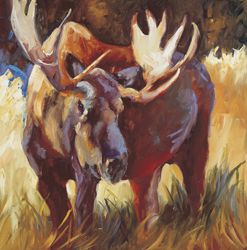 |
| MAGNIFICENT MOOSE, OIL, 36 X 36 |
For an animal lover, there could hardly be a bigger thrill. A buffalo herd under the wide western sky. In this case, artist Linda St. Clair is able to experience the massive animals up close. She moves slowly through the herd on the back of a 4-wheeler driven by a friend who owns the southern Colorado ranch. With names like Oprah and Girlfriend, these bison are so comfortable with people that St. Clair can feed them by hand, or run her hand across the soft fur of a buffalo calf. Living on 80 acres not far from the ranch, it’s no wonder that the artist often finds herself painting large animals these days.
It’s something of a switch from the creatures whose portraits have earned her national acclaim: roosters, goats, and other animals reminiscent of her childhood on a Tennessee farm. While it’s hard to get as close to a wild bear or moose, St. Clair aims at infusing each image with energy and character, often juxtaposing a single animal against the rich, suffused color of an abstracted background.
Married for many years to a fellow artist, who recently passed away, St. Clair has seen her share of city life. But the truism is true, she says: “You can’t take the county out of the girl.” St. Clair’s paintings are at Trailside Galleries, Jackson Hole, WY, and Scottsdale, AZ; Morris & Whiteside Galleries, Hilton Head Island, SC; Big Horn Galleries, Cody, WY, and Tubac, AZ; Austin Gallery, Austin, TX; and El Paseo Gallery, Palm Springs, CA.
Andrea Peyton
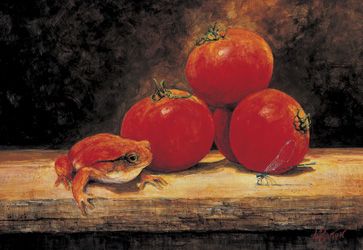 |
| MADAGASCAR TREE FROG, ACRYLIC, 9 1/2 X 13 1/2. |
No, Andrea Peyton says, she doesn’t make this stuff up. She really did see the northern Madagascar tomato frog—the same size and color as ripe tomatoes—in Madagascar. And the tiny Madagascar lemon tree frog actually is smaller than a lemon. Peyton pairs such strange but real creatures with common, familiar fruits whose colors match the animal, and paints them life size—which often means small. These delicate living still-life images are the artist’s way of bridging the exotic and the everyday. Peyton, who lives in the Texas Hill Country near San Antonio, finds her subjects through travel, visits to zoos, herpetology conventions, or by setting down a plate of food outside—where inevitably, she says, “Something shows up.”
She also paints big cats, not quite life-size. These she can watch up close at a nearby wildlife center specializing in cougars and other wild cats rescued from big-game ranches or the mistaken belief that they could be pets. But it is Peyton’s exquisite depiction of the small creatures—Monarch butterflies with pumpkins, green tree frogs with green pears—that she hopes will open the viewer’s eyes to the beauty of pocket-size wildlife they otherwise might miss. “People say, ‘Oh, I didn’t realize that was a real creature.’ Then later they’ll wonder what else they haven’t seen,” she relates. “That makes me happy.” Peyton’s paintings are on view at Southwest Gallery, Dallas, TX; NanEtte Richardson Fine Art, San Antonio, TX; and Art for Wildlife Galleries, Coronado, CA.
Jeff Cochran
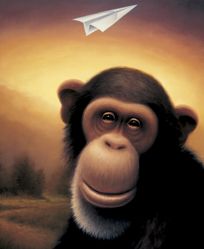 |
| THE VISIONARY, OIL, 56 X 48. |
Funny how things evolve. In college, Jeff Cochran found himself interested in evolution, which prompted him to read about famed chimpanzee researcher Jane Goodall, which led to the inclusion of a few personality-infused chimps in Cochran’s paintings. The chimps brought smiles, which in turn brought the engaging primates to the foreground in the paintings. Then a couple of years ago, the artist sent a large chimp portrait to the Jane Goodall Institute as a donation for the conservation organization’s fund-raising efforts. Soon after, he got a call from the group. They wanted to keep the chimp. It was hanging in Goodall’s office. So Cochran donated another one, and another, and this spring the 33-year-old was invited to attend Goodall’s 70th birthday party in Los Angeles.
Cochran, who divides his time between Taos, NM, and Scottsdale, AZ, also paints serene, atmospheric landscapes and recently has begun a series of large portraits of horses, inspired by the rural setting of his Taos home. In each case he aims for further mastery of what he calls the craftsmanship of painting. And with both the horses and chimps, he’s intrigued by the human-animal connection. How not to be engaged by the disconcertingly direct and intelligent gaze of a creature who seems to have something on his mind? “I find myself going to zoos,” Cochran says. “It’s so bizarre to see these sort-of-human animals. I just love watching them.” Cochran is represented by Deloney Newkirk Fine Art, Santa Fe, NM, and Visions West, Bozeman and Livingston, MT.
William Suys
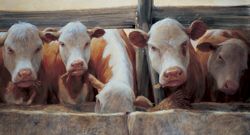 |
| LUNCHEON ENCOUNTER, OIL, 30 X 48. |
Stopped in mid-munch, the placid cows in paintings by William Suys (pronounced Size) appear as much to be the observers as they are the observed. Portrayed at eye level and close range, they’re caught with heads raised and pink-rimmed eyes staring in mute curiosity. They may not be quick or bright, or very wild, but in Suys’ engaging depictions these farm animals project a strong presence and connection with the viewer. That’s one of the Wisconsin-based artist’s primary goals, whether he’s painting animals, human portraits, or the range of other subjects that catch his eye.
Suys started off with a visual orientation. Both his parents were deaf, and their son’s first words were in American sign language. Later he studied commercial art and spent a number of years in corporate life before turning full-time to painting in 1995. His portrayal of cows began with a love of their patterns and shapes but soon shifted to express each creature’s individual character.
Today, along with painting, Suys serves as curator of an international corporate art collection. The experience of meeting artists around the world has taught him that no matter their differences, there is a powerful similarity in the creative passion that comes from deep within. Of his own work he says, “I want to create paintings that come to life, that have a spirit of their own, that really possess a soul.” Suys’ paintings may be seen at The Peterson Gallery, Santa Fe, NM; Art Escape Gallery, Thiensville, WI; and www.artbysuys.com.
Melanie Fain
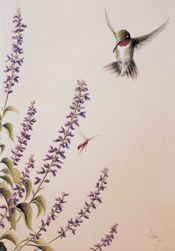 |
| CLASH OF THE TITANS, WATERCOLOR, 10 1/2 X 8. |
An “island of wildness” amidst grazed and managed terrain, Melanie Fain’s seven acres near San Antonio, TX, are thick with live oaks, cedar, Spanish oaks, and all kinds of critters, including birds, deer, snakes, and raccoons. “It’s lively around here,” says the artist, a native Texan who has lived in the state’s south, west, and center, and paid attention to the wildlife wherever she’s been.
In her early 20s, Fain began her artistic career with etching, later using watercolor to hand-tint her prints. From there she explored watercolor itself, and now she divides her award-winning creative output between printmaking and painting. Self-taught in watercolor, she developed a method of applying 30 or more transparent layers to a painting’s background, producing striking yet delicate color gradations. Over this, Zen-like imagery is marked by simplicity of design and a quiet serenity.
Of all the creatures who share Fain’s property, small birds and bugs—along with the botanicals on which they thrive—are the ones she most often portrays. “I seem to be in that miniature world,” she muses. “I gravitate toward what people don’t notice as much. I want to show that some of the overlooked things are as beautiful as the larger ones.” To encounter this beauty, Fain spends much time outdoors, walking, looking closely, carrying a camera. “Nature,” she reflects, “is my livelihood, my recreation, my comfort, my home. It is who I am and what I know best.” Fain’s art is on view at The Hunt Gallery, San Antonio, TX, and Giacobbe-Fritz Fine Art, Santa Fe, NM.
Featured in “Portfolio: Animal Kingdom” June 2004





